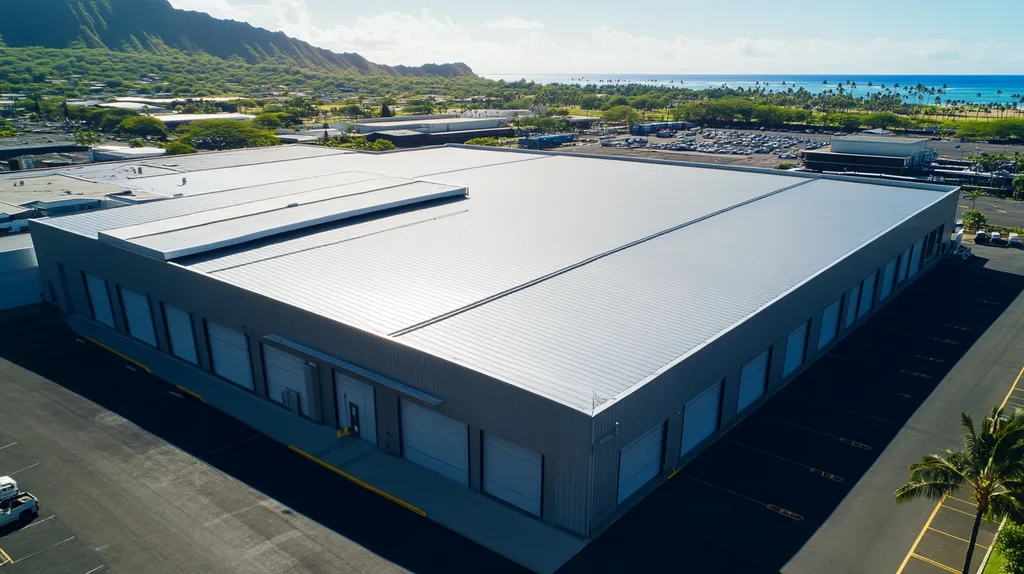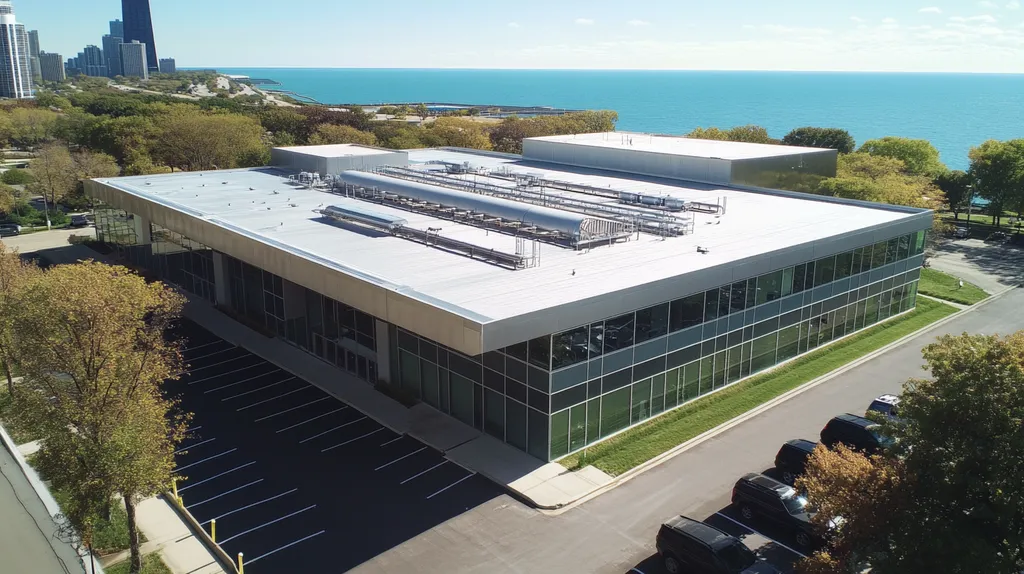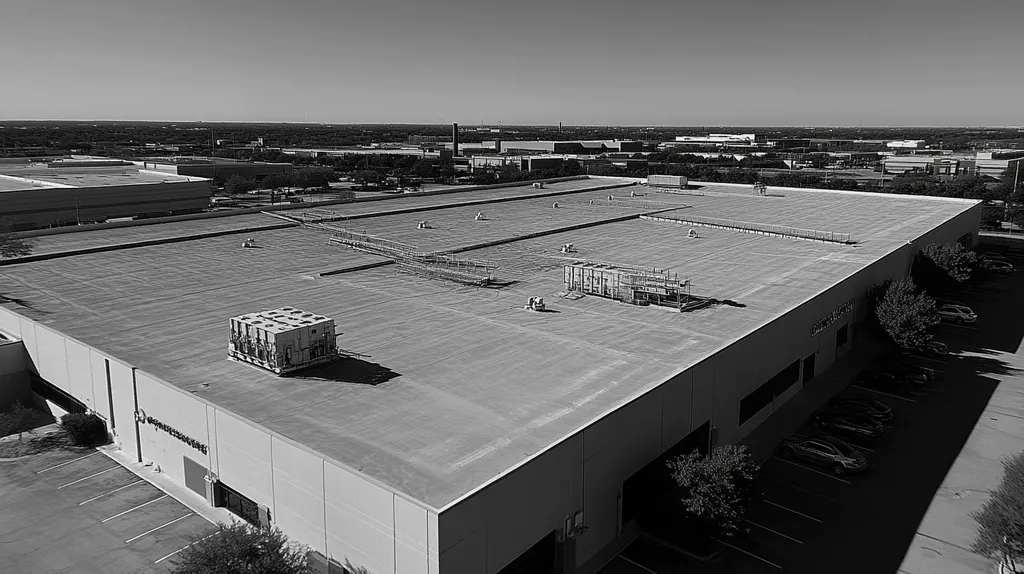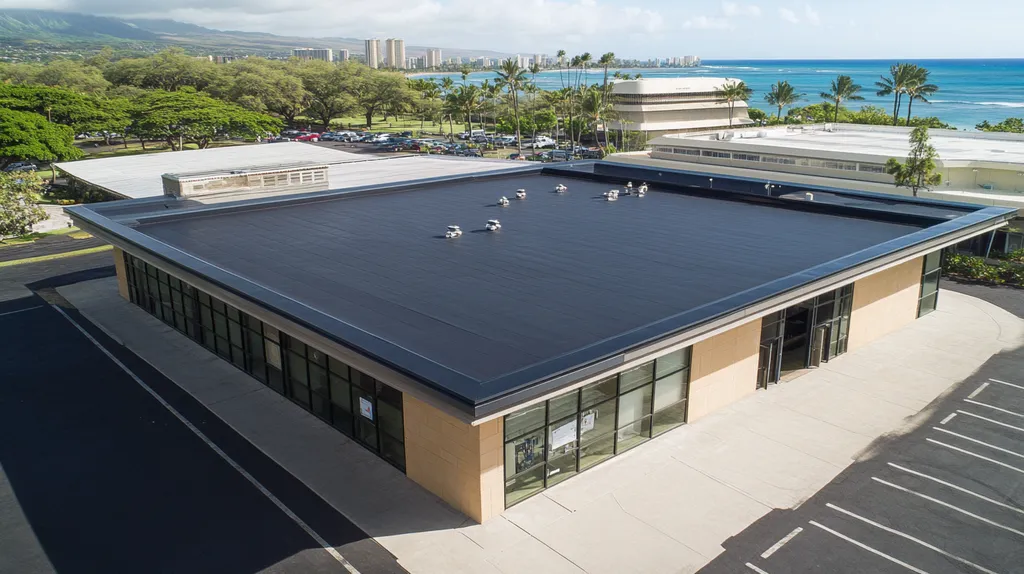Commercial roofs fail prematurely in 85% of cases, costing businesses billions annually in unnecessary replacements and repairs. These failures stem largely from widespread misconceptions about roof system longevity and maintenance requirements.
From installation quality to environmental stressors, numerous factors determine how long a commercial roof will perform as designed. Understanding these critical elements helps property owners protect their investment and avoid costly emergency repairs.
This comprehensive guide examines the key factors affecting commercial roof lifespan, separating industry myths from evidence-based best practices.
SECTION 1: COMMON MISCONCEPTIONS
Commercial roof failures cost businesses billions annually, yet most are preventable. Studies indicate that up to 85% of commercial roofs are replaced prematurely due to misunderstandings about their care and capabilities. These misconceptions not only drain budgets but can also compromise building safety and operations. Understanding three critical areas of confusion – durability expectations, maintenance requirements, and material performance – can help property owners make better roofing decisions.
Overestimating Roof Durability
Many property owners mistakenly equate warranty length with expected roof performance. A 20-year warranty doesn’t guarantee two decades of trouble-free operation – it simply outlines limited manufacturer obligations under specific conditions.
Environmental stressors like UV radiation, thermal cycling, and precipitation constantly challenge roof integrity. Even the most robust systems require regular attention to perform as designed.
Building use patterns also impact roof durability significantly. HVAC equipment maintenance, tenant modifications, and routine foot traffic can create vulnerabilities that accelerate deterioration.
Understanding these real-world limitations helps owners develop realistic expectations and appropriate maintenance strategies rather than assuming their roof will remain serviceable indefinitely.
Ignoring Maintenance Impact
The most dangerous misconception is that commercial roofs are “set it and forget it” systems. This mindset leads to neglect that typically reduces a roof’s functional lifespan by 30-50%.
Small issues like clogged drains or minor tears can quickly escalate into major problems when left unchecked. Regular inspections catch these issues early when repairs are still simple and affordable.
Seasonal maintenance requirements vary significantly by region and roof type. Northern climates demand attention to snow loads and ice dams, while southern locations must address UV degradation and hurricane preparedness.
Creating a documented maintenance program tailored to specific building conditions helps ensure critical tasks aren’t overlooked. This proactive approach typically costs just 1-2% of roof replacement value annually.
Misinterpreting Material Lifespans
Marketing claims about roofing material longevity often reflect ideal laboratory conditions rather than real-world performance. Local climate, building use, and installation quality all significantly impact actual service life.
Different roofing systems have distinct vulnerabilities. Single-ply membranes may be susceptible to punctures, while built-up roofing can struggle with water ponding. Understanding these characteristics is crucial for proper maintenance.
Installation quality often matters more than material selection. The best products will fail prematurely if improperly installed or if critical details like flashings and penetrations aren’t properly addressed.
Success requires matching material selection to specific building conditions and ensuring proper installation by qualified contractors. This approach delivers more predictable performance and better return on investment.
SECTION 2: PRACTICAL IMPLICATIONS
Commercial roof performance hinges on three critical factors that many property owners overlook until it’s too late. Installation errors can create vulnerabilities from day one, while harsh environmental conditions steadily degrade even the best materials. Most critically, maintenance neglect accelerates deterioration, often cutting expected lifespans in half. Understanding these practical realities helps owners protect their investment and avoid costly emergency repairs.
Effect of Poor Installation Practices
Installation quality determines a roof’s performance potential before it faces its first raindrop. Common errors like improper membrane seaming, insufficient slope-to-drain ratios, and inadequate flashing details create weak points that inevitably lead to leaks.
Cost-cutting during installation often triggers a cascade of expensive consequences. Using non-specified materials, skipping critical prep work, or rushing weather-sensitive applications compromises the entire system.
Documentation gaps during installation make warranty claims difficult to pursue. Many manufacturers require detailed installation records, including weather conditions, material batch numbers, and specific application methods.
Third-party installation inspection provides crucial quality assurance. This oversight helps ensure proper techniques, correct materials, and appropriate conditions throughout the installation process.
Role of Environmental Factors
Geographic location dramatically impacts roof performance through exposure to UV radiation, temperature extremes, and precipitation patterns. Southern locations face intense solar degradation, while northern regions battle freeze-thaw cycles and ice dam formation.
Building use patterns interact with environmental stressors to accelerate wear. Kitchen exhaust, chemical emissions, and HVAC vibration can compound natural aging processes.
Wind patterns around buildings create unique stress points that require special attention. Areas of positive and negative pressure can gradually compromise membrane adhesion and seam integrity.
Local microclimates often differ significantly from regional weather data. Nearby bodies of water, urban heat islands, and adjacent structures can create unexpected conditions that impact roof performance.
Consequences of Inadequate Maintenance
Proper maintenance can double a commercial roof’s functional lifespan through early problem detection and timely repairs. Regular inspections catch minor issues before they escalate into major structural problems or interior damage.
Research shows that routine maintenance can increase commercial roof life by 30% to 100%. This preventive approach dramatically reduces lifetime ownership costs while protecting valuable equipment and inventory. (source: Nations Roof)
Drainage system maintenance proves especially critical for roof longevity. Clogged drains, damaged scuppers, and deteriorated gutters quickly lead to ponding water that accelerates membrane aging.
Documentation of maintenance activities protects warranty coverage and helps track system performance. Many manufacturers void coverage if owners cannot prove adherence to required maintenance schedules.
Seasonal maintenance requirements vary significantly by region and roof type. Creating a customized maintenance calendar ensures appropriate timing of critical tasks like drain cleaning, seam inspection, and coating renewal.
SECTION 3: COST OF MISINFORMATION
Misconceptions about commercial roofing drive billions in wasteful spending annually. Studies show that up to 40% of commercial roof replacements occur years before necessary, primarily due to inadequate information and poor maintenance decisions. When building owners act on flawed assumptions, they not only waste capital but often create new problems that compound expenses exponentially.
Financial Impact of Premature Replacements
The direct cost of unnecessary roof replacement typically ranges from $10-25 per square foot, making premature replacement a six or seven-figure mistake for many facilities. These costs spiral higher when factoring in business disruption and potential damage to building contents.
Many premature replacements stem from misdiagnosing repairable issues as complete system failures. Simple problems like isolated leaks or surface weathering often trigger full replacements when targeted repairs would suffice.
Rushed replacements frequently overlook underlying issues like deck deterioration or inadequate drainage. This oversight creates new vulnerabilities that can compromise the replacement system’s performance.
The cascading effect of premature replacement extends beyond immediate costs. New installations often require modifications to other building systems, creating additional expenses that could have been avoided.
Hidden Costs of Roof Leaks and Damage
Water infiltration from unaddressed roof issues typically causes damage worth 5-10 times the cost of proper repairs. Even minor leaks can trigger extensive damage to insulation, structural components, and interior finishes.
Business disruption represents the largest hidden cost, with manufacturing facilities losing up to $5,000 per hour of downtime due to roof-related issues. Retail spaces face similar challenges with customer displacement and inventory damage.
Mold remediation following water damage often exceeds $10,000 per incident, while electrical system repairs can reach six figures. These secondary damages frequently exceed the cost of maintaining the roof properly.
Insurance premiums typically increase after significant water damage claims, creating long-term financial impacts that persist well beyond the initial incident.
Economic Benefits of Proper Maintenance
Regular maintenance typically costs just 1-3% of a roof’s replacement value annually while extending its service life by 25-50%. This investment delivers returns through both extended life cycles and reduced repair frequency.
Preventive maintenance helps identify and correct minor issues before they escalate. Simple repairs like seam reinforcement or drain clearing often prevent thousands in water damage.
Energy efficiency improvements from proper maintenance can reduce HVAC costs by 10-15%. Well-maintained roofs better resist heat transfer and maintain their reflective properties longer.
Strategic maintenance planning allows owners to bundle necessary work efficiently, reducing contractor mobilization costs and minimizing business disruption. This approach typically saves 20-30% compared to reactive repairs.
SECTION 4: REALITY CHECK
Commercial roof lifespans vary dramatically based on material selection, environmental conditions, and maintenance practices. Industry data shows that up to 70% of commercial roofs fail prematurely due to mismatched materials or inadequate maintenance programs. Understanding the real-world performance of different roofing systems, coupled with proper inspection protocols, can extend functional life by decades while protecting capital investments.
Actual Lifespan Expectations by Material
Different roofing materials demand distinct maintenance approaches and deliver varying longevity. Material quality and coating selection significantly impact performance potential across all system types.
TPO and PVC single-ply membranes typically last 20-25 years with proper care, while EPDM systems often reach 30 years when maintained correctly. These thermoplastic options excel in UV resistance but require careful seam maintenance.
The quality of coating materials fundamentally affects system durability, with silicone coatings showing superior resistance to ponding water compared to standard acrylics. Professional installation prevents curing issues that can compromise coating performance. (source: Kangaroof)
Modified bitumen and built-up roofing systems can perform for 25-35 years but demand rigorous drainage maintenance. Metal roofing systems often exceed 40-year lifespans when properly detailed and maintained.
Importance of Regular Inspections
Professional roof inspections should occur at least twice annually, with additional checks following severe weather events. These evaluations help identify developing issues before they compromise system integrity.
Critical inspection points include membrane seams, flashings, drainage systems, and mechanical unit curbs. Early detection of deterioration in these areas prevents costly emergency repairs.
Documented inspections protect warranty coverage and provide valuable trending data about system performance. Many manufacturers require proof of regular inspections to maintain warranty validity.
Digital inspection records help track problem areas and plan preventive maintenance more effectively. This data-driven approach optimizes repair timing and budgeting.
Understanding Roofing System Types
Low-slope commercial roofs utilize either single-ply, multi-ply, or fluid-applied systems, each with distinct performance characteristics. System selection must align with building use, local climate, and maintenance capabilities.
Single-ply systems offer excellent installation flexibility but require careful attention to seam integrity. These membranes can be particularly vulnerable to mechanical damage from foot traffic or debris.
Multi-ply systems provide redundant water protection through multiple membrane layers. This approach better tolerates minor damage but makes leak source identification more challenging.
Fluid-applied systems create seamless coverage and excel at complex geometries. However, their performance depends heavily on proper substrate preparation and application conditions.
SECTION 5: EVIDENCE-BASED ALTERNATIVES
Commercial roofs represent one of the most significant investments for building owners, yet studies show that over 70% of facilities lack evidence-based strategies for maximizing roof performance. Research indicates that proper material selection, maintenance protocols, and technology integration can extend roof lifespans by 25-40 years. However, most properties continue operating with outdated practices that accelerate deterioration and inflate costs.
Selecting the Right Roofing Materials
The commercial roofing sector offers diverse material options, each engineered for specific performance characteristics. Material selection must account for local climate conditions, building use patterns, and maintenance capabilities to deliver optimal results.
The lifespan of a commercial roof typically ranges from 20-60 years, with variation largely dependent on material choice, installation quality, climate conditions, and maintenance frequency. Strategic material selection paired with proper installation can significantly extend functional life. (source: Absi)
Single-ply membranes like TPO and PVC excel in UV resistance and installation flexibility but require careful attention to seam integrity. These systems typically deliver 20-25 year lifespans when properly maintained.
Built-up roofing and modified bitumen systems offer excellent durability and redundant protection but demand strict drainage maintenance. Their multi-layer construction helps resist punctures and mechanical damage.
Metal roofing provides superior longevity and minimal maintenance requirements but requires precise installation. Proper panel attachment and flashing details prove critical for preventing moisture infiltration.
Implementing Effective Maintenance Strategies
Preventive maintenance programs must align with specific roofing system requirements and environmental conditions. Standardized inspection protocols help ensure consistent evaluation of critical components.
Regular assessments should focus on high-risk areas including membrane seams, flashings, drainage systems, and mechanical unit curbs. Early detection of deterioration prevents minor issues from escalating into major failures.
Documentation of all maintenance activities provides valuable trending data while protecting warranty coverage. Digital record-keeping helps track problem areas and optimize repair timing.
Seasonal maintenance requirements vary significantly by region and roof type. Creating customized maintenance calendars ensures appropriate timing of critical tasks like drain cleaning and coating renewal.
Staff training on basic inspection protocols enables quick identification of developing issues. This front-line monitoring supplements professional assessments while reducing response times.
Utilizing Advanced Roofing Technologies
Modern roofing technologies provide unprecedented visibility into system performance. Infrared scanning detects moisture infiltration before visible damage occurs, while drone inspections offer comprehensive documentation without roof access.
Smart sensors monitor critical indicators including temperature, moisture levels, and structural movement. These systems provide early warning of developing issues while optimizing maintenance timing.
Advanced coating systems extend material lifespans through superior weather resistance and self-healing capabilities. New formulations deliver improved adhesion and UV protection compared to traditional options.
Building automation integration enables real-time monitoring of roof conditions and automatic notification of potential problems. This technology helps prevent costly emergency repairs through early intervention.
Digital modeling and asset management platforms streamline maintenance planning while providing detailed performance analysis. These tools help optimize resource allocation and validate improvement strategies.
SECTION 6: TEST AND VERIFY
Commercial roof systems require rigorous testing and verification to prevent premature failure. Studies show that buildings lacking systematic monitoring protocols experience 40% more emergency repairs and face double the lifetime maintenance costs. Without proper oversight, minor issues can quickly escalate into catastrophic failures that compromise building operations and safety.
Conducting Regular Roof Inspections
Commercial roof inspections must follow a systematic approach focused on high-risk components. Membrane seams, flashings, drainage systems, and mechanical unit curbs require detailed examination to catch developing issues early.
Professional inspections should occur biannually at minimum, with additional assessments following severe weather events. These evaluations help identify deterioration patterns before they compromise system integrity.
Inspection documentation provides critical trending data while protecting warranty coverage. Digital records enable precise tracking of problem areas and help optimize maintenance timing.
The lifespan of a commercial roof typically ranges from 20-60 years, varying significantly based on inspection frequency and maintenance response. Regular professional evaluations paired with proper repairs can dramatically extend functional life. (source: Absi)
Using Leak Detection Systems
Modern leak detection technologies provide unprecedented visibility into roof performance. Electronic leak detection (ELD) systems can identify moisture infiltration before visible damage occurs.
Infrared scanning reveals subsurface moisture patterns that indicate developing problems. This technology proves especially valuable for identifying compromised insulation and hidden water migration.
Automated moisture sensors continuously monitor critical areas, enabling immediate response to water infiltration. These systems help prevent minor leaks from escalating into major structural issues.
Integration with building automation systems enables real-time alerts and automated documentation. This connectivity ensures rapid response while maintaining detailed performance records.
Monitoring Roof Performance Over Time
Long-term performance monitoring requires tracking multiple indicators including membrane condition, drainage efficiency, and thermal performance. Regular data collection helps identify deterioration patterns and optimize maintenance timing.
Weather impact analysis correlates environmental conditions with system response. Understanding these relationships helps predict maintenance needs and prevent weather-related failures.
Energy performance metrics reveal changes in insulation effectiveness and membrane reflectivity. Declining thermal efficiency often indicates developing moisture issues or material degradation.
Performance data trending enables proactive maintenance planning and budget optimization. This systematic approach typically reduces lifetime ownership costs by 25-40% compared to reactive maintenance.
The Bottom Line
With commercial roof failures costing businesses over $2 billion annually in unnecessary replacements, understanding roof system longevity has never been more critical.
The data shows that proper material selection, professional installation, and systematic maintenance can extend roof lifespans by 25-40 years while reducing lifetime costs by up to 50%.
Modern technologies like infrared scanning and automated monitoring systems now provide unprecedented visibility into roof performance, enabling early intervention before minor issues become major failures.
For property owners and facility managers, the message is clear: evidence-based roofing strategies, not wishful thinking, protect both buildings and budgets.
The future of commercial roofing lies in proactive management backed by data-driven decision making.
FREQUENTLY ASKED QUESTIONS
Q. What is a common misconception about commercial roof durability?
A. Many property owners believe that a long warranty guarantees a roof’s durability. However, warranties only specify manufacturer obligations under certain conditions and do not ensure trouble-free operation. Regular maintenance is essential to keep the roof durable over time.
Q. How do environmental factors affect the lifespan of an industrial roof?
A. Geographic location influences a roof’s durability due to varying UV exposure, precipitation, and temperature extremes. Southern areas suffer from intense solar damage, while northern regions face freeze-thaw cycles, which can both shorten the roof’s lifespan significantly.
Q. What are the costs associated with premature commercial roof replacements?
A. Premature roof replacements can cost between $10-25 per square foot. These costs can escalate significantly when factoring in disruptions to business operations and potential damage to assets inside the facility, leading to extensive losses.
Q. How does inadequate maintenance impact commercial roof longevity?
A. Neglecting routine maintenance can reduce a roof’s lifespan by 30-50%. Small issues such as clogged drains can develop into major problems, leading to costly repairs and significantly shortening the functional life of the roofing system.
Q. What are the benefits of regular inspections for a commercial roof?
A. Regular inspections identify deterioration early, helping prevent costly emergency repairs. It’s recommended to inspect biannually and after severe weather. Inspections safeguard warranty coverage and ensure the roof maintains its integrity and performance.
Q. How can technology enhance maintenance strategies for commercial roofs?
A. Modern technology, such as drones for inspections and smart sensors for monitoring, enables proactive maintenance. These tools offer detailed data on roof performance, helping owners address issues before they escalate and ensuring optimal investment protection.
Q. What additional steps can owners take to increase their commercial roof’s lifespan?
A. Owners can implement customized maintenance schedules tailored to their roof type and local climate. Regular training for on-site staff in basic roof inspections can also enhance immediate issue detection, prolonging the roof’s functional life effectively.











